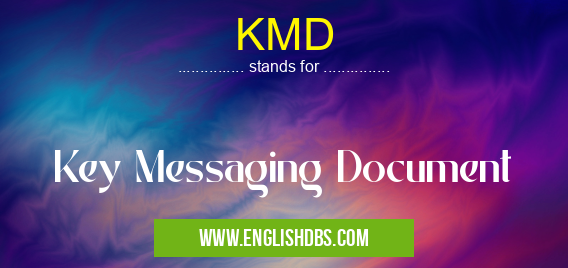What does KMD mean in UNCLASSIFIED
KMD stands for Key Messaging Document. It is a strategic communication tool used to define and communicate the key messages that an organization wants to convey to its target audience. A well-crafted KMD ensures that all communication efforts are aligned and consistent, and that the organization's brand and reputation are protected.

KMD meaning in Unclassified in Miscellaneous
KMD mostly used in an acronym Unclassified in Category Miscellaneous that means Key Messaging Document
Shorthand: KMD,
Full Form: Key Messaging Document
For more information of "Key Messaging Document", see the section below.
Key Elements of a KMD
- Target Audience: Clearly identifies the specific audience that the KMD is intended for.
- Key Messages: Concise and compelling statements that capture the core ideas the organization wants to communicate.
- Supporting Points: Evidence and examples that support and reinforce the key messages.
- Tone of Voice: Establishes the appropriate style and language to be used in all communications.
- Call to Action: Encourages the target audience to take a specific action, such as visiting a website or making a purchase.
Benefits of Using a KMD
- Improved Communication: Ensures that all stakeholders are on the same page regarding the organization's messaging.
- Enhanced Brand Consistency: Maintains a consistent brand image across all channels and interactions.
- Increased Efficiency: Saves time and resources by providing a clear and concise framework for communication.
- Improved Audience Engagement: Delivers targeted and relevant messages that resonate with the target audience.
Essential Questions and Answers on Key Messaging Document in "MISCELLANEOUS»UNFILED"
What is a Key Messaging Document (KMD)?
A KMD is a strategic communication tool that outlines the key messages an organization wants to convey to its audience. It provides a consistent and unified framework for all internal and external communications.
What are the benefits of using a KMD?
Benefits include:
- Ensures consistency in messaging across all channels.
- Clarifies communication goals and objectives.
- Strengthens brand identity and messaging.
- Facilitates efficient stakeholder engagement.
- Improves alignment and coordination of marketing and communication efforts.
Who should be involved in developing a KMD?
Key stakeholders from various departments, including marketing, communications, sales, customer service, and leadership, should collaborate to develop an effective KMD.
What elements should be included in a KMD?
A comprehensive KMD typically includes:
- Target audience definition
- Key message statements
- Supporting evidence and data
- Messaging guidelines for different audiences
- Communication channels and tactics
- Monitoring and evaluation plan
How can I ensure my KMD is effective?
To ensure effectiveness, consider the following:
- Align with organizational goals and objectives.
- Use clear, concise, and persuasive language.
- Focus on audience needs and pain points.
- Provide credible supporting information.
- Regularly review and update the document as needed.
Final Words: A KMD is an essential tool for organizations that want to effectively communicate their key messages and build a strong brand. By providing a clear and consistent framework for communication, a KMD helps organizations achieve their communication goals and connect with their target audience.
KMD also stands for: |
|
| All stands for KMD |
